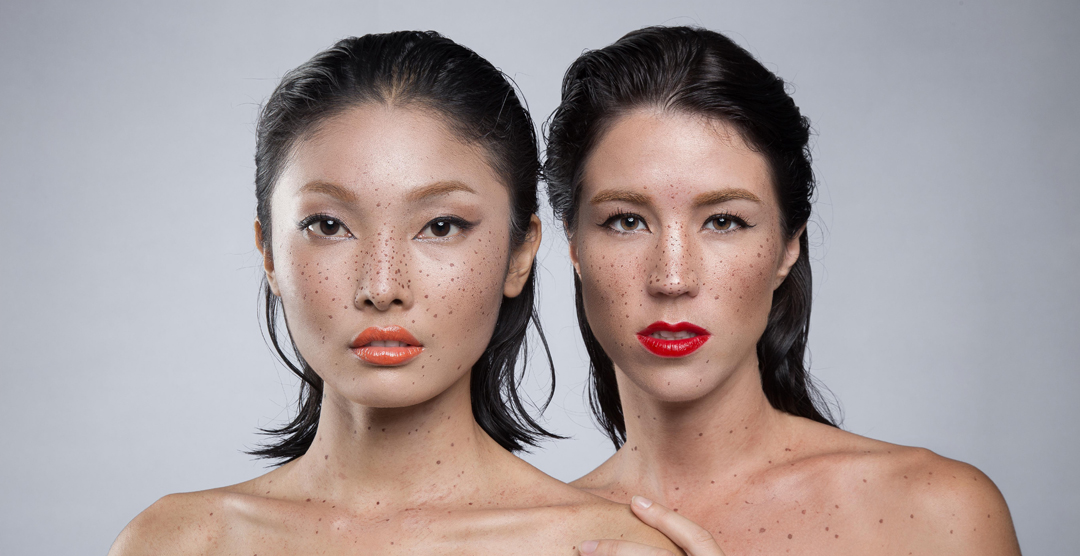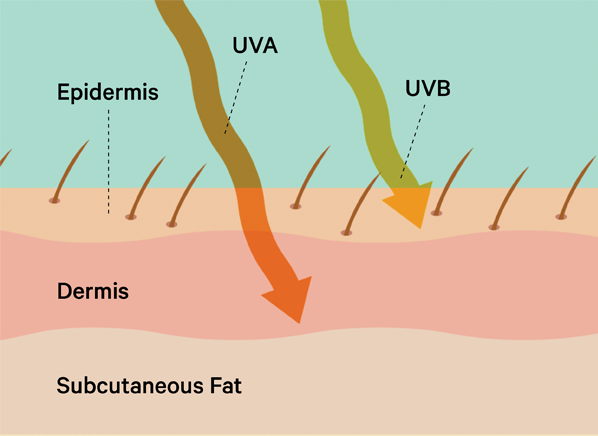What Are Freckles, Why Do They Appear, and More
What are freckles?
Freckles are small brown spots on your skin, often in areas that get sun exposure. In most cases, freckles are harmless. They form as a result of the overproduction of melanin, which is responsible for skin and hair color (pigmentation). Overall, freckles come from ultraviolet (UV) radiation stimulation.
There are two categories of freckles: ephelides and solar lentigines. Ephelides are the common type most people think of as freckles. Solar lentigines are dark patches of skin that develop during adulthood. This includes freckles, aging spots, and sunspots. The two types of freckles can look similar but differ in other ways such as their development.
How do you get freckles?
Ephelides: These freckles form as a result of sun exposure and sunburns. They can appear on anyone who does not protect themselves from UV rays. They show up on your face, the back of your hands, and upper body. This type tends to be most common amongst people with lighter skin tones and hair color. People of Caucasian and Asian descent are more prone to ephelides.
Solar lentigines: Like ephelides, this type tends to appear in Caucasians and adults over 40 years old.
What increases your chance for freckles?
The credit for freckles goes to both the natural environment and genetics. Your risk for burning can increase the incidence of freckles.
In a study of 523 middle-aged French women, two elements predicted the presence of freckles: frequent sunburns and a gene known as MC1R, which provides instructions for making melanin. But the gene does not affect all individuals the same way. There are two types of melanin: pheomelanin and eumelanin.
People whose skin produces pheomelanin are not protected from UV radiation and tend to have:
Red or blonde hair
Light skin
Freckles
Skin that tans poorly
People with more eumelanin tend to be protected from skin damage by UV and have:
Brown or black hair
Darker skin
Skin that tans easily
Solar lentigines
For solar lentigines, the French study also found that several different factors increased the likelihood, including:
Dark skin
The capacity to tan
A history of freckles
Sun exposure
Hormone treatment, such as oral birth control
What’s the difference between freckles and sunspots?
All freckles fall into the ephelides and solar lentigines category, although freckles and sun spots can differ. Solar lentigines include sunspots, which can sometimes be scaly.
What's the difference between freckles and moles?
Moles are not the same as freckles. They are still skin lesions but are often darker and not necessarily associated with sun exposure. Like ephelides though, moles are more common among light-skinned people.
A mole is made of an excess of pigment-forming cells with a higher than average supply of blood vessels. It usually's present at or soon after birth.
Moles can take on a wide variety of appearances. The color can range from brown to pink and can assume different shapes. On a young person, a harmless mole will keep pace with a person's growth.
Should I see a doctor for my freckles or moles?
Freckles and moles by themselves pose no threat. But moles can suggest an increased risk for melanoma, or malignant skin cancer.
Do a self-exam to check your freckles and moles for:
A – Asymmetry: Draw a line through the middle. If the halves don't match, it's asymmetrical.
B – Border: Borders of cancerous moles tend to be uneven, notched, or bumpy.
C – Color: A variety of colors in a mole is a warning sign.
D – Diameter: A mole bigger than 1/4 inch (a pencil tip) may be cancerous.
E – Evolving: Report any change in size, shape, color, or elevation to your doctor.
Make an appointment with your doctor or a dermatologist if your freckles, moles, or sunspots display one or more of the above criteria.
Moles can increase the risk of skin cancer
The risk of melanoma increases with the number of moles. Someone with 11-25 moles can have 1.6 times increased the risk for melanoma. This can be as high as 100 times more for someone with 100 moles or more.
Other risks for melanoma include:
having fair skin
Red hair and blue eyes
A history of non-melanoma skin cancer
A history of excessive tanning or sun exposure
In one analysis, the risk of melanoma for white populations was approximately 32 and 20 times higher than people with darker skin. Annual screening is a good idea if you fall into one of the at-risk categories or develop a new mole.
Can I prevent more freckles from appearing?
For people who want to avoid freckles, prevention is key. It is also possible to prevent freckles while speeding up their disappearance. The American Academy of Dermatology recommends using a water-resistant sunscreen with an SPF of at least 30 on your skin. Wait 15 minutes before heading outdoors for full protection. Do this every day, even in the winter, to prevent further pigmentation.
"You really can't freckle unless you've had sun exposure," explains Dee Anna Glaser, MD, chair of the department of dermatology at St. Louis University. "Even if you inherit that tendency, if your mom and dad were the most amazing sunscreen advocates and kept you out of the sun, you probably still wouldn't freckle."
Over-the-counter prevention
One study reported excellent results for lightening freckles and skin pigmentation with products such as:
Alpha hydroxy acids (8% AHA toner)
Trichloracetic acid (TCA)
Phenol
Acid peels
You can purchase acid and chemical peels online. The study above reports Jessner Solution as a potential treatment for freckles. Always patch-test to avoid skin irritation, if you are using a facial peel at home. Wash off the peel immediately if your skin starts to burn and do not leave on for longer than instructed.
Laser therapy
Suggests laser therapy to lighten or remove freckles. "Some fractionated resurfacing lasers can work beautifully not only on the face, but on the chest, or upon the upper shoulders. Another popular target for these lasers is freckles on legs above the knees, where people get sun exposure from boating and similar activities."
The fractionated lasers resurface by targeting the water that's inside the skin's layers. It drills through the layers until it reaches that middle layer of the dermis. This causes the old epidermal pigmented cells to be expelled, and the reaction leads to collagen remodeling and new collagen formation.
Sunspot removal
By comparison, sunspots don't generally fade with less sun exposure. Instead, they can be treated with:
Hydroquinone
Retinoid creams
Chemical peels
Cryotherapy
Laser therapy
There other lasers that target skin pigments. Instead of going through layers of skin, these laser target and destroy the pigmented areas. The pigment-specific lasers work well on sunspots.
All about freckles
Freckles and moles almost always are harmless but may suggest an increased risk of skin cancer. Knowing your risk and particulars of the ABCDE rubric for assessing changes in skin pigmentation will help with identifying any freckles or moles that may be dangerous. Talk to your doctor about your freckles, moles, or sunspots. They'll be able to help identify spots for you to monitor closely.
5 DANGERS OF PROLONGED SUN EXPOSURE
Are you counting the days until you can turn in your pasty white winter skin for a lovely shade of tan? While we are 100 percent in support of daily doses of fresh air and sunshine, sun exposure is one of those areas in which “too much of a good thing can be dangerous.” Here are five things to be cautiously aware of as you prepare your family for a healthy and safe summer.
1) SHORT-TERM SKIN DAMAGE
You can receive a sunburn in less than 15 minutes, although it may not show for another two to six hours. This form of radiation burn comes an overexposure to ultraviolet, or UV, rays. The skin reddening is often accompanied by pain and blistering, and if severe enough, second-degree burns.
2) LONG-TERM SKIN DAMAGE
Even if you don’t burn often, extended exposure to UV rays over a lifetime accelerates the aging of your skin. You may start to see more wrinkles, dryness, sagging and a dull, leathery look. Pigment changes are known as “age spots” appear, and your skin bruises more easily. Changes in the skin cells caused by prolonged exposure may lead to skin cancer, the most common of all cancers.
It’s especially important to protect your children from sunburn. Ultraviolet radiation increases the risk of three types of skin cancer: melanoma, basal cell carcinoma, and squamous cell carcinoma. However, sunburns that occur in childhood are often cited as posing the highest risk for developing melanoma later in life. The Skin Cancer Foundation warns:
“Sustaining five or more sunburns in youth increases lifetime melanoma risk by 80 percent. On average, a person’s risk for melanoma doubles if he or she has had more than five sunburns.”
3) HEAT STROKE
Heat stroke may begin as heat cramps, fainting or exhaustion, but as it progresses, it can damage the brain and other internal organs, sometimes fatally. While often seen in adults over age 50, healthy young high school or college athletes often succumb to life-threatening heat stroke while performing strenuous workouts in high temperatures.
When combined with dehydration, prolonged exposure to extreme heat causes the body’s temperature control system to fail, resulting in a core body temperature higher than 105 degrees Fahrenheit. Common symptoms of heat stroke include:
Dizziness and light-headedness
Throbbing headache
Nausea and vomiting
Muscle cramps or weakness
Rapid heartbeat and rapid, shallow breathing
Confusion, disorientation, staggering, seizures, loss of consciousness or coma
Call 911 immediately, and keep the person as cool as possible by seeking shade. Remove unnecessary clothing, fan them with air and wet the skin if possible.
4) DEHYDRATION
Dehydration occurs when more water is moving out of our cells and bodies than the amount we take in through drinking. Our body’s fluid levels become unbalanced, and severe dehydration can lead to death. If you notice your urine is dark yellow, it’s a good sign that you may be dehydrated.
Other signs of dehydration include:
Increased thirst, decreased urine output, inability to sweat
Dizziness and weakness
Dry mouth and swollen tongue
Heart palpitations
Fainting, confusion, sluggishness
Encourage dehydrated adults and children to sip small amounts of water, sports drinks like Gatorade or Pedialyte. Sucking on ice chips or popsicles is helpful too.
5) HIVES
Hives that result from sun exposure are called solar urticaria. These large, itchy red welts can develop within 5 minutes of sun exposure and usually disappear within an hour or two after leaving the sunlight. People with this rare condition also experience headaches, weakness, and nausea. This hypersensitivity can be severely disabling and even life-threatening. Worldwide, 3.1 per 100,000 people are affected, and females are more likely to be affected than males.
What is SPF Sunscreen?
SPF, or Sun Protection Factor, is a measure of how well a sunscreen will protect skin from UVB rays, the kind of radiation that causes sunburn, damages skin, and can contribute to skin cancer.
If your skin would usually burn after 10 minutes in the sun, applying an SPF 15 sunscreen would allow you to stay in the sun without burning for approximately 150 minutes (a factor of 15 times longer). This is a rough estimate that depends on skin type, the intensity of sunlight and the amount of sunscreen used. SPF is a measure of protection from the amount of UVB exposure, and it is not meant to help you determine the duration of exposure.
For best protection, experts recommend using a minimum SPF sunscreen of 15, applying the proper amount (2mg/cm2 of skin, or about one ounce for full body coverage), and reapplying every 2 hours.
Most people under-apply sunscreens, using ¼ to ½ the amount required. Using half the required amount of sunscreen only provides the square root of the SPF. So, a half application of an SPF 30 sunscreen only provides an effective SPF of 5.5!
The SPF (Sun Protection Factor) scale is not linear:
SPF 15 blocks 93% of UVB rays
SPF 30 blocks 97% of UVB rays
SPF 50 blocks 98% of UVB rays
So, one way of looking at this is that SPF 30 sunscreen only gives you 4% more protection than SPF 15 sunscreen.
Or, another way of looking at it is:
SPF 15 (93% protection) allows 7 out of 100 photons through
SPF 30 (97% protection) allows 3 out of 100 photons through.
So, while you may not be doubling your level of protection, an SPF 30 will block half the radiation that an SPF 15 would let through to your skin.
It is complicated, but to keep it simple, most dermatologists recommend using an SPF 15 or SPF 30 sunscreen.
Why not use a high Sun Protection Factor? Sunscreens with really high SPF, such as SPF 75 or SPF 100, do not offer significantly higher protection than SPF 30 and mislead people into thinking they have more protection than they do. Additionally, to have broad-spectrum protection, the UVA protection should be at least 1/3 of the UVB protection. High SPF sunscreens usually offer far greater UVB than UVA protection, thus providing a false sense of full protection.
SPF Sunscreen Testing
All sunscreens must undergo FDA approved SPF testing to make a UVB claim. There are three main types of SPF testing; SPF Static, SPF Water Resistant 40 Minutes, and SPF Water Resistant 80 Minutes. All sunscreen manufacturers must adhere to the same FDA approved tests, ensuring that the SPF claims are consistent across all sunscreens, chemical, and mineral. All SPF testing is conducted in vivo (with human subjects).
Understanding how a sunscreen works help you get the best protection
SPF (sun protection factor) is a relative measure of how long a sunscreen will protect you from ultraviolet (UV) B rays. The chief cause of reddening and sunburn, UVB rays tend to damage the epidermis, skin’s outer layers, where the most common (and least dangerous) forms of skin cancer occur. Those cancers are linked to sun-accumulation over the years. Another type of skin cancer, melanoma, is thought to be caused by brief, intense exposures, such as a blistering sunburn.
Assuming you use it correctly if you’d burn after 20 minutes in the sun, an SPF 30 sunscreen protects for about 10 hours. But the intensity and wavelength distribution of UVB rays varies throughout the day and by location. And that calculation does not apply to UVA rays.
UVA rays are long enough to reach skin’s dermal layer, damaging collagen, and elastic tissue. That layer is also where the cells that stimulate skin darkening are found; that’s why UVA rays are considered the dominant tanning rays. (UVA rays are also used in tanning beds.) Though many people still think a tan looks healthy, it’s a sign of DNA damage—the skin darkens in an imperfect attempt to prevent the further injury, which can lead to the cell mutations that trigger skin cancer.
Why You Need UV Protection in the Spring
It may not be 85 degrees yet, but it is time to get back into the sunscreen habit
After a long, cold winter, nothing feels better than the arrival of those first few warm, sunny spring days. Suddenly, everyone is stripped down to short sleeves—kids on the playground, people planting their gardens or exercising outdoors. But before you trade in your parka for a T-shirt, be sure to spring into sun protection mode. Here is why it matters.
It Doesn't Have to Be Hot for You to Burn
"People have a misperception about how outside temperature affects the intensity of the sun's rays," says Joel L. Cohen, M.D., director of AboutSkin Dermatology and DermSurgery in metropolitan Denver. "The reality is that UV radiation is present regardless of temperature"—as anyone who's ever gotten sunburned during a ski trip can attest.
Spring sun can also be intense. The sun is at its highest angle in the summer—which means that's when the strongest UV rays are hitting our skin. But by late spring, UV rays can be summer strength in many areas of the country.
According to the Environmental Protection Agency, the average UV Index (a measure of the sun's intensity) in April is at moderate to high levels in the mid-Atlantic, Midwestern, Southern, and Southwestern states. That's nearly as high as you'll find in August in those areas.
More Daylight Means More Hours Outdoors
One of the benefits of springing the clocks forward is that the days are suddenly, and increasingly, long. And while that means extra hours of daylight to play and work outdoors, it also adds up to more sun exposure. Remember that exposed skin—like your face, neck, and arms—needs sunscreen before you head outside. And it requires a second application if you stay in the sun for more than a couple of hours. Although the type of rays that cause burning, UVB, is strongest between 10 a.m. to 4 p.m., the UVA rays that cause wrinkles and skin cancer are present whenever the sun is out year-round.
Spring Travelers Need Sunscreen
If your spring vacation takes you to the beach or a ski resort, you'll need plenty of sunscreens to keep your skin protected.
That's because water, sand, and snow all reflect damaging rays. Your skin gets a double whammy of UV rays—directly from the sun, and again as the rays bounce back up. According to the World Health Organization, flat water reflects less than 10 percent of UV light; sand reflects about 15 percent; the foam in a choppy ocean reflects 25 percent; snow reflects nearly 50 percent.
If you're at the beach or someplace warm, you're also likely to have more skin exposed that needs to be covered in sunscreen. In the mountains, it may be just your face that's seeing the sun, but remember that being at higher altitudes (most of the ski resorts in Colorado, for example, are over 8,000 feet above sea level) means more intense sun. For every 1,000 feet, you gain in elevation, the sun's rays are about 10 to 15 percent stronger, according to Douglas Grossman, M.D., Ph.D., professor of dermatology and oncological sciences, University of Utah.
Summer Sunscreen Rules Apply in Spring Too
Practicing smart sun protection should be a year-round habit. That means applying sunscreen (about a teaspoon-sized blob per exposed body part) 15 to 30 minutes before heading outdoors—and reapplying it every two hours or immediately after being in the water.
And consider buying a new bottle instead of reaching for last summer's leftovers. Sunscreen does remain effective for about three years, but not all containers have an expiration date, and sunscreen can go bad before that time if it hasn't been stored at room temperature.
Finally, don't simply slap on a sunscreen and think you're good to go. It's also smart to seek shade (especially between 10 a.m. and 4 p.m. when rays are strongest), wear a wide-brimmed hat, and cover up with clothing.
Prevention
Avoiding excessive exposure to ultraviolet radiation can reduce the risk of skin cancer.
This can be achieved by:
avoiding sunburn
wearing clothes that protect against the sun
using a sunscreen with a minimum sun protection factor (SPF) of 15, but preferably SPF 20-30, with 4- or 5-star UVA protection
liberally applying sunscreen about half an hour before going out, and applying it again after half an hour
reapplying every 2 hours and after swimming to maintain adequate protection
Avoiding the highest sun intensity between 11 am and 3 pm by finding shade.
protecting children by keeping them in the shade, with clothing, and by applying SPF 50+ sunscreen
keeping infants out of direct sunlight
Wearing sunscreen is not a reason to spend longer in the sun. Sun exposure should still be limited, where possible. People who work outdoors should take precautions to minimize exposure.
Doctors recommend avoiding tanning booths, lamps, and sunbeds.
What about vitamin D?
Despite warnings against overexposure to the sun, it remains essential to get a little sun exposure as this enables our bodies to produce vitamin D.
Vitamin D is an essential nutrient for the prevention of diseases such as rickets and osteomalacia. As such, sensible sun exposure is advised.
The time it takes to produce sufficient vitamin D is less than the time it takes to get sunburnt. This means we can enjoy the sun safely and maintain optimal vitamin D levels without dramatically increasing the risk of skin cancer.








